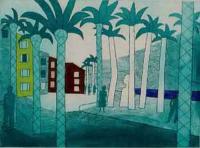Julian Trevelyan
Born: 1910
 |
Born in 1910, in Dorking, Surrey Trevelyan's work spanned more than 55 years. In that time he exhibited alongside Picasso, Miro and Dali, was a member of the English Surrealist Group and an active participant in the Mass Observation Movement, taught at both the Royal College of Art and Chelsea, and wrote a number of books.
For several years in the early 1930s he studied with S W Hayter at Atelier 17 in Paris. His early work was experimental, his paintings incorporating everyday objects. At University he had written that "to dream is to create" and so it was logical that he became one of the English Surrealist Group in 1936. During service as a camouflage officer in the Royal Engineers during World War II he declared his religion to be Surrealism.
Trevelyan's work has always defied categorisation and much of its interest derives from the apparently opposing instincts towards figurative realism and poetic fantasy. He was happily producing straightforward gouaches of Spain and the West of Ireland alongside Surrealist inspired painted wooden collages influenced by Paul Klee and Ben Nicholson.
In the early years of the 50s there was a gradual change of direction in his style, the softer "French" manner giving way to a tougher more linear style with much stronger colours bounded by thicker, heavier black outlines. This has links with the St. Ives' painters like Frost, Winter and Heron.
He was a tutor at the Chelsea School of Art and engraving tutor at the Royal College of Art. His autobiography Indigo Days was published in 1957.
Since the Second World War his work was mainly concerned with depicting scenes from around his Hammersmith home and of the River Thames.
View work by Julian Trevelyan >>
Show printable version of this page (opens in new window) >>